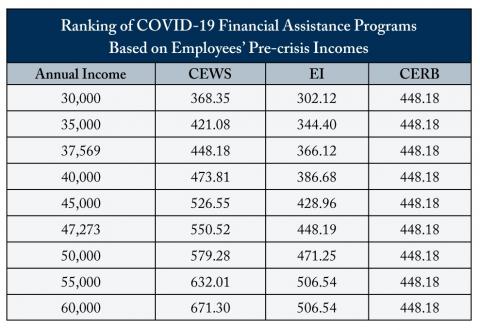From: Amin Mawani and Salim Hajee
To: Concerned businesses and employees
Date: April 27, 2020
Re: Assessing how Ottawa’s new wage subsidy lines up with EI and CERB
The Canada Emergency Wage Subsidy (CEWS) program has opened and businesses need to incorporate the estimated level of after-tax financial assistance offered to their employees by the CEWS, Employment Insurance (EI) and the Canada Emergency Response Benefit (CERB) into their decision-making.
This memo presents a quantitative analysis of these three programs to guide both employers and employees.
The CERB is more beneficial to employees earning less than $37,569, while the CEWS is more beneficial to employees earning more. But the CEWS has additional advantages by offering businesses a competitive edge once economic activity resumes by keeping employees on their payroll.
The wage subsidy is equal to 75 percent of pre-crisis weekly salary to a maximum of $847 per week. The subsidy is offered to employers that can demonstrate a 15 percent or greater decline in revenues (not profits) between March 2020 and March 2019, or between March 2020 and the average of January and February 2020. For April and May 2020, the decline in revenue has to be at least 30 percent compared to the same months in 2019 or compared to the average of the first two months of 2020.
While businesses have to apply on Canada Revenue Agency’s web portal each claim period, an employer would automatically qualify in the immediately following period if they were considered eligible in an earlier period. This provision – designed to increase certainty for the employer – makes the second period’s requirement to be effectively the same as the first period’s requirement – namely, demonstrating a 15 percent decline in revenues instead of 30 percent. For example, if a firm experienced a 20 percent decline in revenues in the first claim period, then it would qualify for the CEWS for both the first and second claim periods. For the third claim period, the employer would have to show a 30 percent decline to qualify. Firms may therefore want to apply for the CEWS sooner to meet the less stringent revenue reduction test for the first period.
Currently, the choice between applying for EI or CERB is up to the employee applicant. Assuming the criteria for both programs are met (not a trivial assumption), CERB offers higher after-tax cash flows than EI for Canadians earning up to $47,273, with EI becoming more lucrative for earnings in excess or $47,273.
The choice between EI and CERB on the one hand and CEWS on the other hand is up to the employer. CEWS offers employees higher after-tax cash flows compared to both CERB and EI at pre-crisis annual wages higher than $37,569.
The after-tax weekly cash flow under CERB is $448.18 (=$500 fixed weekly payout - $51.82 income tax payable at tax-filing time). A pre-crisis annual wage of $37,569 yields a gross weekly payment of $541.86 under CEWS – i.e., 75 percent of ($37,569 / 52) = $541.86. This results in a net weekly cash flow of $448.18 after income tax, CPP and EI deductions – the same as the after-tax cash flow from CERB.
The comparative weekly after-tax cash flows available to the employee from each of these three programs are summarized in the figure below.
The employer’s costs are almost equally negligible for all of the above three programs if the employee is on “paid leave” and not doing any work, since the CEWS even reimburses the employer-level CPP and EI premiums. If an employee works remotely during the pandemic, the employer has to continue paying the employer-level premiums for CPP and EI.
Both employers and employees should know which program is the most financially advantageous. Obviously, employers should keep their employees’ best interests in mind.
However, there are additional advantages for employers to retain employees through the CEWS. Businesses that do not retain employees may take longer to restart production as customers start to come back. Businesses that are better prepared with a motivated labour force already on payroll may be able to advertise their contingency plans and differentiate themselves from competitors that have not retained and engaged their employees. In a competitive business environment, businesses need to consider that the costs of inaction may be greater than the costs of action.
Retaining and engaging employees during the disruption can also be a part of an organization’s corporate social responsibility. Managing employees by viewing them as internal customers can contribute to their job satisfaction, loyalty, retention and productivity. Keeping employees productive and healthy keeps their interests aligned with those of the owners or shareholders.
Amin Mawani is Associate Professor of Taxation at Schulich School of Business at York University, and Salim Hajee is CEO at EmployeeSoft Inc.
To send a comment or leave feedback, email us at blog@cdhowe.org.
The views expressed here are those of the author. The C.D. Howe Institute does not take corporate positions on policy matters.






